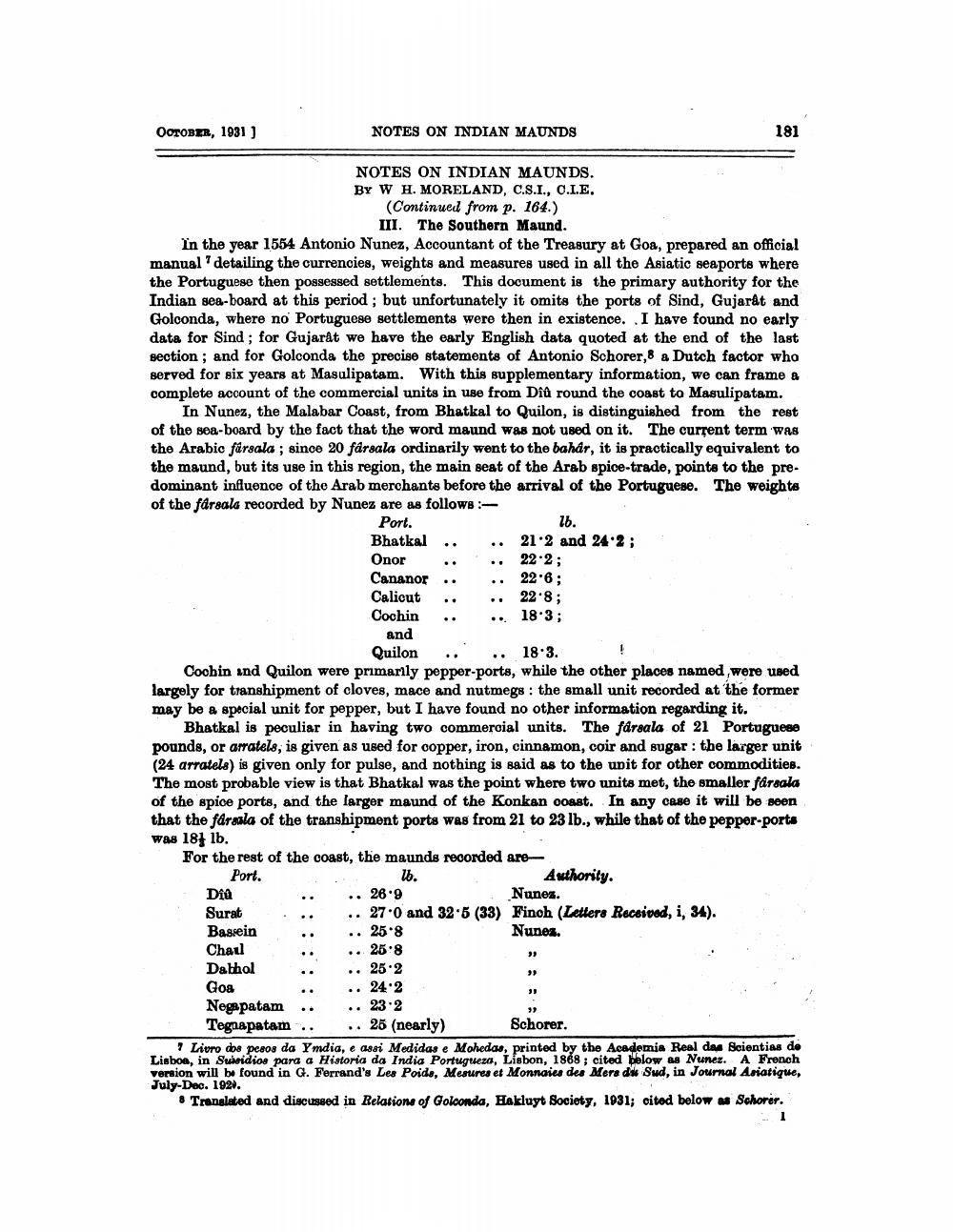________________
OCTOBER, 1931 )
NOTES ON INDIAN MAUNDS
181
NOTES ON INDIAN MAUNDS. BY W H. MORELAND, C.S.I., O.I.E.
(Continued from p. 164.)
III. The Southern Maund. In the year 1554 Antonio Nunez, Accountant of the Treasury at Goa, prepared an official manual' detailing the currencies, weights and measures used in all the Asiatic seaports where the Portuguese then possessed settlements. This document is the primary authority for the Indian sea-board at this period ; but unfortunately it omits the ports of Sind, Gujarat and Goloonda, where no Portuguese settlements were then in existence. I have found no early data for Sind; for Gujarat we have the early English data quoted at the end of the last section; and for Golconda the precise statements of Antonio Schorer, 8 a Dutch factor who served for six years at Masulipatam. With this supplementary information, we can frame & complete account of the commercial units in use from Dîû round the coast to Masulipatam.
In Nunez, the Malabar Coast, from Bhatkal to Quilon, is distinguished from the rest of the sea-board by the fact that the word maund was not used on it. The current term was the Arabic fårsala ; since 20 farsala ordinarily went to the bahar, it is practically equivalent to the maund, but its use in this region, the main seat of the Arab spice-trade, points to the predominant influence of the Arab merchants before the arrival of the Portuguese. The weights of the farsala recorded by Nunez are as follows:
Port.
16. Bhatkal .. .. 212 and 242; Onor
222; Cananor.. 22.6; Calicut .. .. 22.8; Cochin
18.3; and
Quilon .. .. 18.3. Cochin ind Quilon were primarily pepper-ports, while the other places named were used largely for transhipment of cloves, mace and nutmegs: the small unit recorded at the former may be a special unit for pepper, but I have found no other information regarding it.
Bhatkal is peculiar in having two commercial units. The farsala of 21 Portuguese pounds, or arratels, is given as used for copper, iron, cinnamon, coir and sugar : the larger unit (24 arratels) is given only for pulse, and nothing is said as to the unit for other commodities. The most probable view is that Bhatkal was the point where two units met, the smaller farsala of the spice ports, and the larger maund of the Konkan coast. In any case it will be seen that the faraala of the transhipment ports was from 21 to 23 lb., while that of the pepper-ports was 184 lb. For the rest of the coast, the maunds recorded are Port.
16.
Authority. .. 28.9
Nunes. Surat
.. 27.0 and 32.5 (38) Finch (Letters Received, i, 34). Basrein
Nunea Chaul
.. 25:8 Dathal
25.2
.. 24-2 Negpatam .. .. 23.2
Tegnapatam.. 25 (nearly) Schorer. ? Livro dos pesos da Ymdia, e assi Medidas e Mohedas, printed by the Academia Real des Scientias de Lisboa, in Suidios para a Historia da India Portugueza, Lisbon, 1868; cited below as Nunez. A French version will be found in G. Ferrand's Les Poids, Mesures et Monnaies des Mera du Sud, in Journal Asiatique, July-Dec. 1920.
& Translated and discussed in Relations of Golconda, Hakluyt Society, 1931; cited below a Schorer.
Dia
Goa
31




